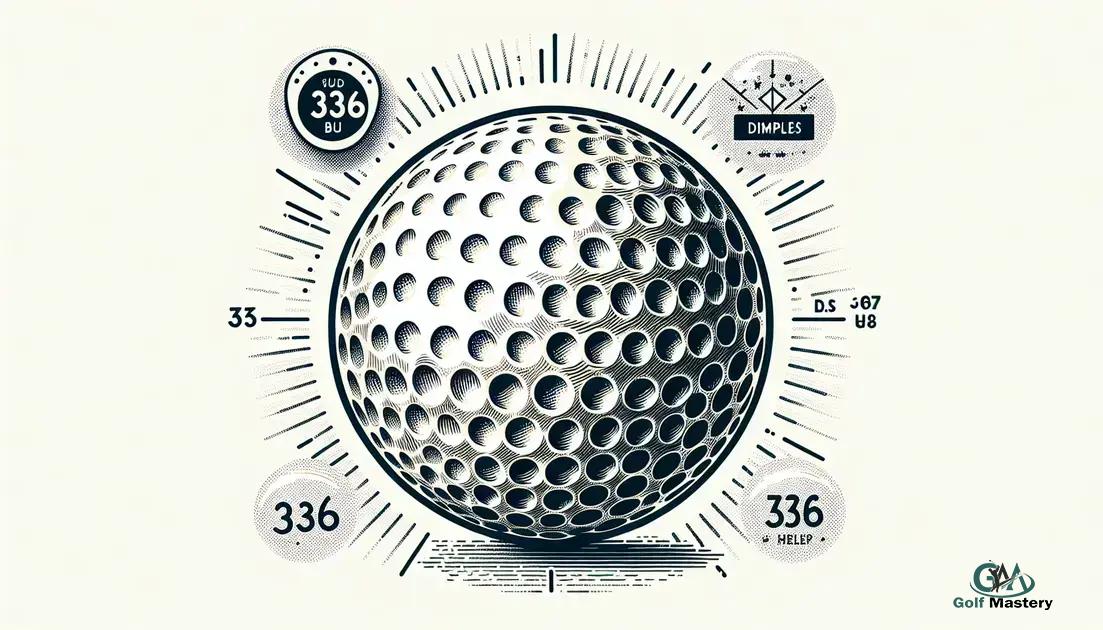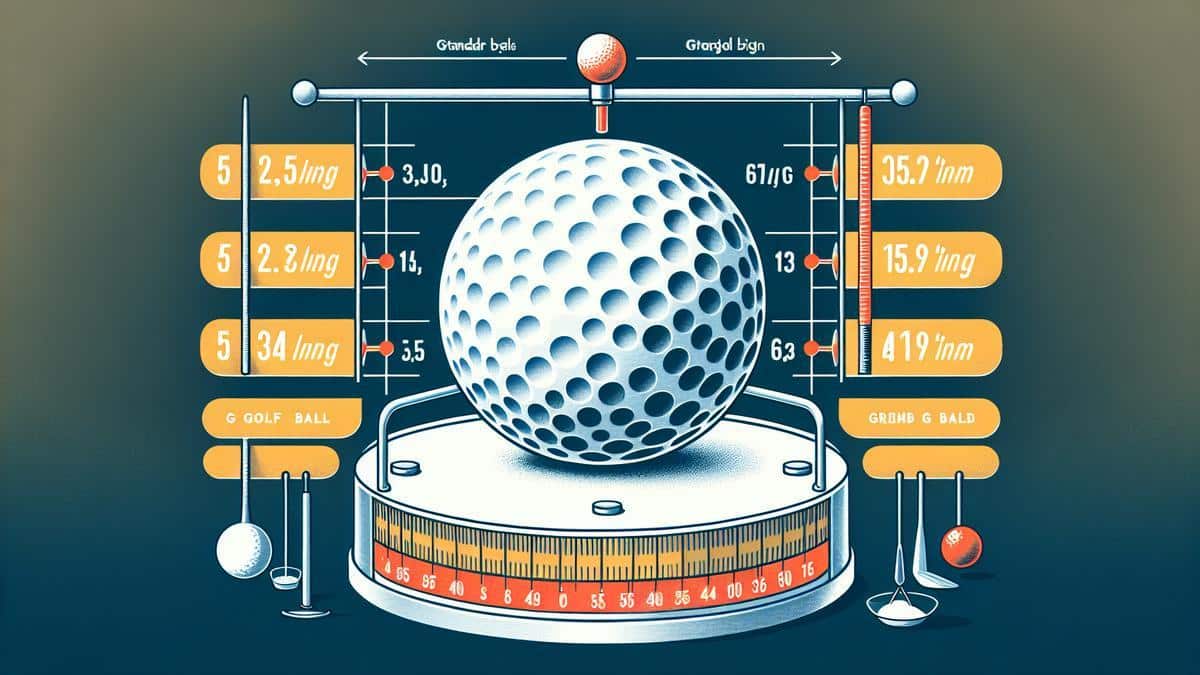How many dimples does a golf ball have? Discover the surprising answer that affects your game and performance on the green. Read more!
The number of dimples on a golf ball, usually between 300 and 500, significantly affects its performance. More dimples can enhance lift and control, but the best choice depends on individual skill level and playing style.
Have you ever asked yourself, how many dimples does a golf ball have? The answer might surprise you! Dimples play a crucial role in a golf ball’s performance, impacting everything from aerodynamics to how well the ball travels through the air. In this article, we will break down the science behind these small features and explore their importance in your golf game. Let’s delve into the fascinating world of golf ball dimples and why they matter.
Understanding Golf Ball Dimples
Golf balls are designed with a unique feature: dimples. These small indentations on the surface of the ball play a critical role in how the ball performs during a game. Understanding golf ball dimples is essential for players looking to improve their game.
What Are Dimples?
Dimples are small, circular indentations that cover a golf ball’s surface. On average, a golf ball has between 300 and 500 dimples. The exact number varies depending on the ball’s design and brand. Dimples help create turbulence in the air around the ball, which can reduce drag.
Why Are Dimples Important?
The main purpose of dimples is to enhance aerodynamics. A smooth golf ball would experience much more drag as it travels through the air. By creating a turbulent airflow, dimples allow the ball to stay in the air longer. This results in greater distance and better accuracy.
The Shape and Depth of Dimples
The shape, depth, and arrangement of the dimples can affect how the ball behaves in flight. Different golf manufacturers have their specific dimple patterns, which can alter factors like lift and drag. Athletes should consider these variations when selecting a golf ball for their playing style.
Dimples and Spin
Dimples also influence how the ball spins when struck. A well-designed dimple pattern enables players to hit different shots, such as fades or draws, more effectively. Understanding this can help players choose the right ball for their desired spin and control on the green.
By comprehensively understanding the role of dimples in golf balls, players can make better choices about which golf balls to use. This knowledge can lead to improved performance on the golf course and might even lower scores.
The Science Behind Dimples
The science behind dimples on a golf ball is fascinating and plays a crucial role in how the ball behaves in flight. When a golf ball is hit, it moves through the air. The dimples create a layer of turbulent air around the ball. This turbulence reduces drag, allowing the ball to travel farther.
Lift and Drag
To understand how dimples work, let’s look at two important concepts: lift and drag. Lift is the force that helps the ball rise in the air, while drag is the resistance that slows it down. Dimples help manage these forces to enhance performance.
How Dimples Cause Turbulence
As the ball moves, the smooth surface would typically create a lot of drag. However, dimples change this by creating patterns of turbulence. The air moves faster over the dimples, reducing pressure on the top of the ball. This pressure difference causes lift, enabling the ball to stay in the air longer.
Testing and Design
Golf ball manufacturers use advanced technology to design dimples. They conduct tests using wind tunnels and computer models to see how different dimple shapes affect performance. These studies help determine the best dimple patterns for optimal flight.
Real-World Applications
The principles of aerodynamics used in golf ball dimples also apply to planes and cars. Engineers study how surfaces can minimize drag and improve lift, showcasing the significance of these scientific concepts not only in sports but also in various technologies.
Thus, understanding the science behind dimples can help golfers appreciate how their equipment works and why certain balls might suit their playing style better. Knowledge about these factors can greatly influence a player’s game strategy.
Effects of Dimples on Ball Flight
The effects of dimples on ball flight are significant and influence how a golf ball performs in the air. Dimples help to control two major factors: distance and accuracy.
Distance
Dimples can greatly enhance the distance a golf ball travels. As previously mentioned, they create turbulence in the air, reducing drag. This allows the golf ball to travel farther than a smooth ball. The optimal dimple design can add yards to your shot!
Trajectory
Dimples also affect the ball’s trajectory. A well-designed dimple pattern helps the ball soar higher and stay in the air longer. This is crucial when hitting approach shots to reach the green effectively. A higher launch angle can lead to better landing conditions.
Spin Control
Another key factor influenced by dimples is spin. When a player strikes the ball, the dimples help it grip the clubface better, leading to increased spin. Higher spin rates allow for more control over shots, which is especially important for putting and short-game shots.
Wind Resistance
Dimples can also help the ball resist wind effects. A golf ball with a proper dimple pattern can cut through the air, minimizing side effects from wind gusts. This gives players a steady and predictable ball flight, even in less than perfect weather conditions.
Choosing the Right Ball for Flight
Understanding how dimples affect ball flight helps players pick the best golf ball for their needs. Some players may prefer balls with more dimples for added spin, while others might choose fewer dimples for maximum distance. Knowing these options can enhance gameplay.
Are More Dimples Better?
The question are more dimples better? is often debated among golfers. While it seems that having more dimples could improve performance, the reality is more complex. Different designs cater to various playing styles.
The Role of Dimples
Dimples primarily affect how the ball travels through the air, influencing factors like lift and drag. Balls typically have between 300 to 500 dimples. While it might appear that more dimples mean better performance, this is not always the case.
Impact on Distance
Balls with more dimples can sometimes create more lift, which helps with distance. However, the relationship between the number of dimples and overall distance isn’t straightforward. The dimple pattern, depth, and shape also significantly affect how far the ball can fly.
Effects on Spin
More dimples generally lead to a higher spin rate, allowing golfers to have better control over their shots. Increased spin is beneficial for short games and putting but can be a disadvantage on long-distance shots. Players must consider their strategy when choosing a ball.
Choosing the Right Number of Dimples
Different players have different needs. For instance, a beginner golfer may benefit from a ball with fewer dimples for more distance, while an advanced player may prefer more dimples for enhanced control. Understanding playing style helps in selecting the ideal dimple count.
Manufacturer Variations
Golf ball manufacturers design their products based on extensive research. The results of testing different dimple numbers and patterns indicate that there is no one-size-fits-all answer. Players should experiment with balls of varying dimple counts to find what works best for them.
How to Choose the Right Golf Ball
Choosing the right golf ball can make a significant difference in your game. Here are several factors to consider when selecting a golf ball that fits your needs.
Understand Your Skill Level
First, assess your skill level. Beginners may benefit from a softer ball that provides more distance and forgiveness. Intermediate and advanced players often prefer balls that offer more control and spin. This can help tailor your game strategy according to your abilities.
Consider Ball Type
There are mainly three types of golf balls: two-piece balls, three-piece balls, and four-piece balls. Two-piece balls are great for beginners, focusing on distance. Three-piece and four-piece balls offer better control and spin, which are ideal for experienced players.
Evaluate Dimple Count
Different golf balls come with various dimple patterns and counts. More dimples can provide better lift and control, while fewer dimples may add distance. Experimenting with different options can help you find the right fit for your swing.
Check Compression Ratings
Compression ratings indicate how soft or hard a ball feels when struck. Lower compression balls work well for slower swing speeds, providing a softer feel. Higher compression balls are better for faster swings, offering more control and distance.
Test Different Brands
Finally, don’t be afraid to test balls from different brands. Each brand has unique technology and designs that might better suit your playing style. Many golf stores offer sleeve options, allowing you to try various balls before committing to a full box.
In Summary: Choosing the Right Golf Ball for Your Game
Understanding how many dimples a golf ball has, the science behind them, and their impact on flight can elevate your game significantly.
By considering factors like your skill level, the type of ball, dimple count, compression ratings, and trying out different brands, you can find the ideal golf ball that suits your playing style.
Ultimately, choosing the right golf ball isn’t just about distance; it’s about performance and control that aligns with your individual needs on the course. Take the time to explore options, and improve your experience each time you tee off.
FAQ – Frequently Asked Questions about Golf Balls
How many dimples does a golf ball typically have?
A golf ball usually has between 300 and 500 dimples, depending on the design and manufacturer.
Do more dimples mean better performance?
Not necessarily. While more dimples can enhance lift and spin, the best choice depends on your playing style and preferences.
What type of golf ball is best for beginners?
Beginners should consider using two-piece balls, as they offer more distance and are more forgiving on mishits.
How do compression ratings affect golf ball performance?
Lower compression balls are suitable for slower swing speeds, providing a softer feel, while higher compression balls are suited for faster swings, offering better control.
Can testing different brands really make a difference?
Yes, different brands often have unique technologies and designs that can significantly impact your game. Testing multiple options can help you find the best fit.
What factors should I consider when choosing a golf ball?
Consider your skill level, the type of ball (two-piece, three-piece, or four-piece), dimple count, and compression rating to find the right golf ball for your game.






Leave a Reply